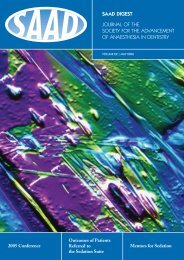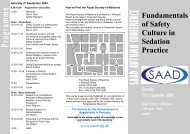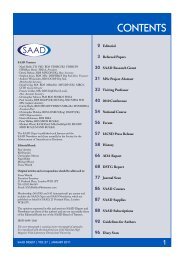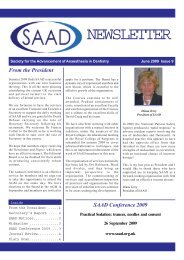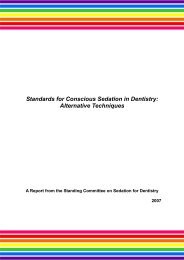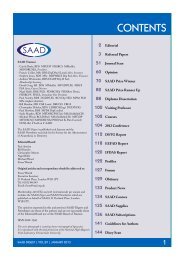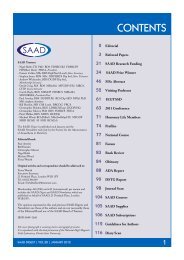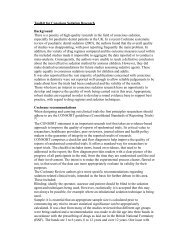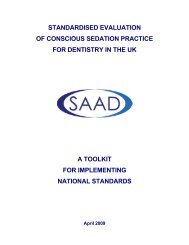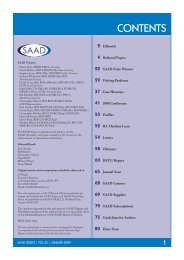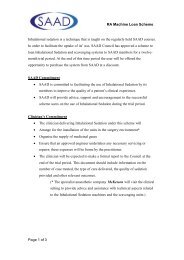Volume 24 - The Society for the Advancement of Anaesthesia in ...
Volume 24 - The Society for the Advancement of Anaesthesia in ...
Volume 24 - The Society for the Advancement of Anaesthesia in ...
You also want an ePaper? Increase the reach of your titles
YUMPU automatically turns print PDFs into web optimized ePapers that Google loves.
VISITING PROFESSOR<br />
In addition to mislead<strong>in</strong>g <strong>in</strong><strong>for</strong>mation, memory can<br />
also be altered when we fill <strong>in</strong> <strong>the</strong> gaps <strong>of</strong> our memory<br />
<strong>for</strong> an experience with guesses or thoughts about how<br />
it probably was (5, 6) . <strong>The</strong>se guesses, <strong>the</strong>n, similar to <strong>the</strong><br />
mis<strong>in</strong><strong>for</strong>mation provided <strong>in</strong> questions or through o<strong>the</strong>r<br />
means, are stored with <strong>the</strong> gist <strong>of</strong> <strong>the</strong> event and may<br />
become part <strong>of</strong> <strong>the</strong> memory at <strong>the</strong> next construction<br />
(recall<strong>in</strong>g) <strong>of</strong> <strong>the</strong> event.<br />
Th<strong>in</strong>k <strong>of</strong> <strong>the</strong> medical and dental fields as hav<strong>in</strong>g <strong>the</strong>ir<br />
own cultures. <strong>The</strong>y def<strong>in</strong>itely have <strong>the</strong>ir own language<br />
and term<strong>in</strong>ology, <strong>the</strong>ir own specific physical space, as<br />
well as cloth<strong>in</strong>g and realms <strong>of</strong> possible experiences and<br />
behaviours. <strong>The</strong> experience <strong>of</strong> a patient, new to and<br />
unfamiliar with this culture, parallels <strong>the</strong> behaviour <strong>of</strong><br />
someone who has travelled to a <strong>for</strong>eign country where<br />
<strong>the</strong>y are unfamiliar with <strong>the</strong> language, customs and<br />
behaviours <strong>of</strong> <strong>the</strong> new culture. As such, <strong>the</strong> different<br />
and unfamiliar events will be <strong>in</strong>terpreted and encoded<br />
differently from how <strong>the</strong>y actually occurred. In addition<br />
to <strong>the</strong> <strong>in</strong>fluence schemas have on encod<strong>in</strong>g, <strong>the</strong>ir use<br />
may also result <strong>in</strong> memory errors created when we beg<strong>in</strong><br />
fill<strong>in</strong>g <strong>in</strong> <strong>the</strong> gaps <strong>in</strong> <strong>the</strong> construction <strong>of</strong> <strong>the</strong> memory.<br />
Perhaps you really do not recall <strong>the</strong> <strong>in</strong>jection you received,<br />
but your sedation schema dictates that <strong>the</strong> anaes<strong>the</strong>sia<br />
was adm<strong>in</strong>istered by an <strong>in</strong>jection; <strong>the</strong>re<strong>for</strong>e, you report<br />
you received an <strong>in</strong>jection and possibly even that you<br />
recall be<strong>in</strong>g given an <strong>in</strong>jection. <strong>The</strong>n when your spouse<br />
asks you, ‘How pa<strong>in</strong>ful was <strong>the</strong> shot?’ you add ‘pa<strong>in</strong>’ to<br />
<strong>the</strong> event <strong>of</strong> <strong>in</strong>jection and restore that to be retrieved at a<br />
later date. Essentially, a new, false memory has now been<br />
created, that <strong>of</strong> a pa<strong>in</strong>ful <strong>in</strong>jection.<br />
Failed sedation, from <strong>the</strong> patient’s perspective, can be<br />
<strong>in</strong>credibly traumatic. When identify<strong>in</strong>g elements <strong>of</strong><br />
patient satisfaction or dissatisfaction from a sedation<br />
experience, Coyle and colleagues (7) found that memory<br />
<strong>for</strong> <strong>the</strong> procedure significantly impacted on satisfaction<br />
reports. Of <strong>the</strong> patients dissatisfied with <strong>the</strong> operation,<br />
20.9% recalled hav<strong>in</strong>g pa<strong>in</strong>. Additionally, when explor<strong>in</strong>g<br />
patients’ memory <strong>of</strong> <strong>the</strong> operation, 32.1% reported<br />
be<strong>in</strong>g awake, 6% <strong>of</strong> those be<strong>in</strong>g unable to communicate.<br />
Particularly if <strong>the</strong> cl<strong>in</strong>ician is unaware <strong>of</strong> <strong>the</strong> patient’s<br />
state, care may not be taken <strong>in</strong> topics <strong>of</strong> verbal<br />
discussions, techniques that are quicker ra<strong>the</strong>r than less<br />
pa<strong>in</strong>ful may be chosen and unfamiliar noises may<br />
become encoded as terrify<strong>in</strong>g and negative ra<strong>the</strong>r than<br />
rout<strong>in</strong>e. With this <strong>in</strong>creased level <strong>of</strong> emotion, <strong>the</strong> patient<br />
will keep th<strong>in</strong>k<strong>in</strong>g about <strong>the</strong>se facts, streng<strong>the</strong>n<strong>in</strong>g<br />
<strong>the</strong>ir recall possibilities, and <strong>in</strong> lieu <strong>of</strong> knowledge <strong>of</strong> <strong>the</strong><br />
procedural ‘culture’, uncerta<strong>in</strong>ty may be stored as fear<br />
and pa<strong>in</strong>.<br />
Q.) I want to give <strong>the</strong> pre-operative <strong>in</strong>structions <strong>for</strong> my<br />
patient <strong>in</strong> <strong>the</strong> best possible way so that <strong>the</strong>y will be able<br />
to remember <strong>the</strong>m, tell <strong>the</strong>ir spouse what to expect,<br />
remember to arrange a ride, not eat or dr<strong>in</strong>k be<strong>for</strong>e <strong>the</strong><br />
procedure, be on time, wear loose cloth<strong>in</strong>g, short sleeves<br />
<strong>for</strong> cannula placement, not be nervous, etc. What<br />
processes are at play and how do I capitalise on <strong>the</strong>m?<br />
To be remembered, <strong>in</strong><strong>for</strong>mation must first be encoded.<br />
Although it sounds like common sense to say this, many<br />
people rema<strong>in</strong> surprised about certa<strong>in</strong> <strong>in</strong><strong>for</strong>mation<br />
<strong>the</strong>y are unable to recall. We use schemas to encode<br />
<strong>in</strong><strong>for</strong>mation.<br />
A schema is a cognitive structure that provides a<br />
mean<strong>in</strong>gful framework <strong>for</strong> organis<strong>in</strong>g <strong>in</strong><strong>for</strong>mation. To<br />
build schemas, we use knowledge and assumptions <strong>of</strong><br />
people, objects, events and <strong>the</strong> world, and construct<br />
<strong>the</strong> frameworks us<strong>in</strong>g <strong>the</strong> ma<strong>in</strong> ideas, or <strong>the</strong> gist <strong>of</strong> <strong>the</strong><br />
<strong>in</strong><strong>for</strong>mation. While not every detail is conta<strong>in</strong>ed <strong>in</strong> <strong>the</strong><br />
schema, details are easily added back <strong>in</strong>to <strong>the</strong> recall<strong>in</strong>g<br />
<strong>of</strong> <strong>the</strong> event us<strong>in</strong>g this framework. Schemas aid <strong>in</strong> <strong>the</strong><br />
efficiency <strong>of</strong> encod<strong>in</strong>g, storage, and <strong>the</strong> retrieval <strong>of</strong><br />
<strong>in</strong><strong>for</strong>mation. Very young children have poorer memory<br />
than older children, as <strong>the</strong>y are unable to extract <strong>the</strong><br />
gist <strong>of</strong> an event or <strong>in</strong><strong>for</strong>mation but ra<strong>the</strong>r attempt to<br />
remember it verbatim. As we age and develop cognitively,<br />
we develop <strong>the</strong> ability to extract <strong>the</strong> gist from an event to<br />
be remembered.<br />
Although it is time-<strong>in</strong>tensive, <strong>the</strong> cl<strong>in</strong>ician might take<br />
this opportunity to help <strong>the</strong> patient build a sedation<br />
schema. Teach<strong>in</strong>g people what is important <strong>in</strong> <strong>the</strong><br />
procedural process essentially <strong>in</strong>structs <strong>the</strong>m as to what<br />
<strong>the</strong>y should pay attention to. In build<strong>in</strong>g <strong>the</strong> schema ask<br />
whe<strong>the</strong>r <strong>the</strong>y have had pre-operative <strong>in</strong>struction <strong>in</strong> <strong>the</strong><br />
past, and whe<strong>the</strong>r <strong>the</strong>y know what to expect. Do not<br />
make <strong>the</strong> assumption, if a patient says she has been <strong>in</strong><br />
<strong>the</strong> dental surgery be<strong>for</strong>e and knows what to do, that her<br />
recall <strong>of</strong> your pre-operative <strong>in</strong>structions will be better<br />
than a patient gett<strong>in</strong>g <strong>the</strong>m <strong>for</strong> <strong>the</strong> first time. Previous<br />
<strong>in</strong><strong>for</strong>mation (<strong>in</strong>structions from a prior session) may<br />
<strong>in</strong>terfere with your patient’s ability to recall your more<br />
recent <strong>in</strong>structions. This proactive <strong>in</strong>terference occurs<br />
especially when subject matters are so very similar, so that<br />
it is easier <strong>for</strong> <strong>the</strong> learn<strong>in</strong>g <strong>of</strong> old material to <strong>in</strong>terfere<br />
with <strong>the</strong> patient’s ability to recall <strong>the</strong> new <strong>in</strong>structions.<br />
In order to create conditions most likely to result <strong>in</strong><br />
<strong>the</strong> highest level <strong>of</strong> adherence to <strong>the</strong> pre-operative<br />
<strong>in</strong>structions, <strong>the</strong> <strong>in</strong>structions first need to be learned<br />
or encoded so that at <strong>the</strong> appropriate time <strong>the</strong>y will<br />
SAAD DIGEST | VOL.<strong>24</strong> | JANUARY 2008 19




